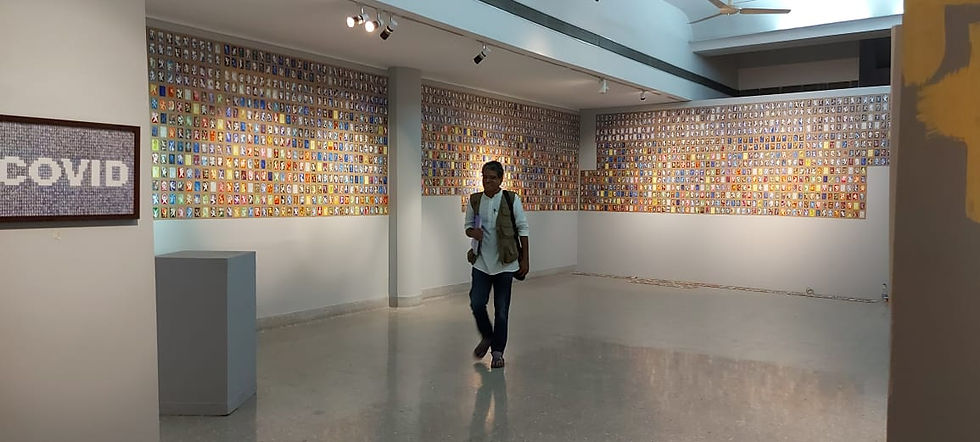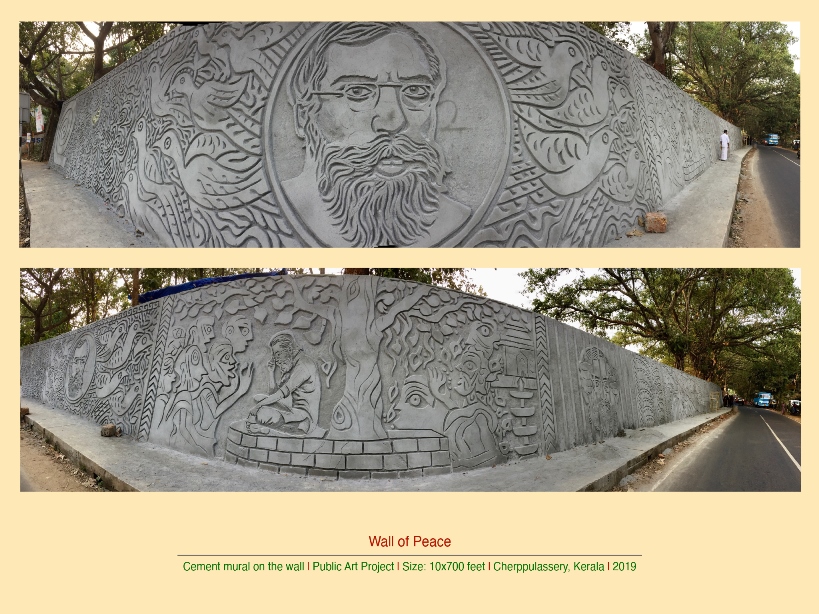by Alka Chadha Harpalani
“Drawing is an immediate way of articulating an idea,
of making a gesture that is both physical and intellectual.”
— Jeff Koons
Suresh K. Nair shaped thousands of miniature paintings on visiting cards – dance-like and trance-like – with a sensitive transposition of simple forms during the pandemic lockdown. It was an impromptu idea, an experiment, designed for presentation to each resident of an art village in Kerala as a token of brotherhood.
Suresh K. Nair
“Once, while waiting for my flight from London to Lisbon, I noticed a woman walking with a dancer’s gait. I felt inspired to draw her but my sketchbook and drawing materials were checked in with my luggage. Finally, I took my own visiting card and drew her image on the reverse side of the card . . . thus was born the artistic idea of creating images in a miniature style that fit within the limited size of a visiting card,” shares Suresh.
For him, this act of creation was therapeutic, having been compulsorily confined to a room while recovering from the Covid infection. He created 4,500 handmade visiting cards of 2” x 3” size, which took shape in the form of an autobiographical narration of his stressful experience, articulated through 108 Karnas, a thousand Buddhas, and traditional shadow puppets of Kerala (called Pavakkoothu), yogic postures, and daily observations.
“I have found a kind of meditation, and the practice has become a visual mantra that gives a lot of positive energy to the body,” says the artist. “I believe the art is miniature and minimal at the same time. We were all living minimalist versions of life during the lockdown, and my work highlights that.”
Curated by Parnab Mukherjee, the entire collection of lockdown miniature paintings is currently on display as a gigantic, composite work spanning three walls, in the Birla Academy of Art in Kolkata titled, ‘Notes from the lockdown annus horriblis twice over’ – the exhibition will remain open till 24 December 2021. The process of compiling all the miniature artworks together appears more like a performance, where the artist can be witnessed in various clicks sitting, kneeling down, posing over a stool and arranging the composition. The assemblage has been a part of various shows including ‘Lokame Tharavadu’ curated by Bose Krishnamachari at Allappey, Kerala’; Busan Museum, Korea curated by Asharafi S Bhagat; and ‘Kashi Avinashi’ curated by Prof. Pradosh Mishra.

Notes from the lockdown annus horriblis twice over at the Birla Academy of Art and Culture
Born in 1971 in Adakkaputhur, Kerala, Suresh K. Nair was a recipient of the National Diploma in Mural Painting from the Institute of Mural Painting Guruvayur, Kerala. He pursued his art education from the Silpa Chithra College of Art, Pattambi, and later on from the Department of Painting, Viswabarati University, Santiniketan. Each of these institutions influenced his practice of creating visual elements based on diverse foundations, sources and styles. His work enfolds myriad aspects which mirror the classical dance forms of Guruvayur, the poetic writings of Rabindranath Tagore, the traditional forms of music, Mexican mural art and many other contemporary art practices. As Miles Davis expressed, “A painting is music you can see and music is a painting you can hear.” Suresh says that he was always captivated by Kathakali, Bharatanatyam, Mohiniyatam, Theyyam and Thira and would do random sketches to arrest the movements. This led to his getting commissioned by the French artist, Brigith Revelli, to draw postures and hand gestures of Katkhali dancers, which were later exhibited at the French Cultural Center of Trivandrum, New Delhi and even in Paris.

Wall mural at the International Chandramauli Charitable Trust

Tyler School Arts, Temple University, Philadelphia, Fulbright Fellowship Program in 2005-06

Suresh at Kushtia city

Wall of Peace

Crack International Art camp
Suresh K. Nair has been honoured with the Elizabath Green Shield Foundation Scholarship (1999) of Canada; the Fulbright Fellowship ( 2006–07) for an Educational Exchange Program at Tyler School of Art, Temple University, Philadelphia under Prof. Nicholas Kripal; and the State Award of Kerala Lalit Kala Akademi, Ministry of Culture, Government of Kerala. He has had his teaching experience at Sri Sankaracharya Sanskrit University in Kalady and is at present settled in the culturally rich city of Varanasi working as a Professor in Banaras Hindu University, which has brought to his work new dimensions of varied sounds, music and rituals. “The reverberating Vedic chanting, the evening Ganga arati, the sounds of cycle rickshaws, the Ramleela of Ramnagar, Drupad Mela, and the Kabir Festival enthralled me with their divine sounds, and inspired a body of ten thousand drawings based on Indian Classical Music,” he explains. He lets the music seep into his soul and then comes up with his gripping drawings crystallizing and flowing with the music, the intensity of realization and recognition of spirit. This linear world of tangled, recurring and dancing curves can thus be seen in his small format miniatures on display at the exhibition.
As Henry Miller aptly said, “No one medium is sufficient to express the wealth of feeling which burdens the soul of an artist.”

Miniature paintings

Miniature paintings

Imaging Sounds

Music and drawing
More works and videos of Suresh K. Nair can be seen on his website: www.sureshknair.com
(All images are courtesy of Alka Chadha Harpalani and the artist, Suresh K. Nair.)

Dr Alka Chadha Harpalani is an artist, researcher, writer, poet, and has worked as a professor. She is involved in an e-learning project by MHRD (Ministry of Human Resource and Development) at Dayalbagh University, Agra. Editor of the journal Artistic Narration (Anubooks) for over 10 years and recipient of many prestigious awards and honours, she has held and participated in many all India and International exhibitions, and published research papers and articles in renowned art journals, newspapers and magazines.













Comentarios